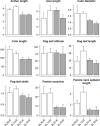Phenological and morphological variations of Oryza rufipogon and O. nivara in Sri Lanka and their evolutionary implications
- PMID: 39730894
- PMCID: PMC11680812
- DOI: 10.1038/s41598-024-82383-x
Phenological and morphological variations of Oryza rufipogon and O. nivara in Sri Lanka and their evolutionary implications
Abstract
Phenological and morphological variation are widely viewed as a pivotal driver of ecological adaptation and speciation. Here, we investigate variation patterns of flowering phenology and morphological traits within and between O. rufipogon and O. nivara populations in Sri Lanka by incorporating the in situ observation in natural habitats and manipulative experiments in the common gardens. First, we observed varying degrees of phenological variation under different temporal and spatial conditions, suggesting that flowering phenology of two Oryza species varied depending on both environments and management practices. Particularly, the Sri Lankan O. nivara exhibits high plasticity in flowering phenology, implying that O. nivara might not be an annual in the strict sense. Second, the observation that flowering time of the two species overlapped suggests that the primary factor to maintain the species divergence in Sri Lanka may not be flowering time but rather environments. Third, our selection analysis suggests that interspecific divergence in the traits related to reproduction and habitat preference is adaptive and most likely driven by natural selection. Together, our case study on the Sri Lankan O. rufipogon and O. nivara enhances the understanding of the roles of phenotypic plasticity and environmental factors in the processes of adaptation and speciation.
Keywords: Ecological divergence; Flowering phenology; Morphological traits; Population variation; Wild rice.
© 2024. The Author(s).
Conflict of interest statement
Declarations. Competing interests: The authors declare no competing interests.
Figures







Similar articles
-
Population genetics and evolutionary history of the wild rice species Oryza rufipogon and O. nivara in Sri Lanka.Ecol Evol. 2018 Nov 11;8(23):12056-12065. doi: 10.1002/ece3.4665. eCollection 2018 Dec. Ecol Evol. 2018. PMID: 30598799 Free PMC article.
-
Divergence in flowering time is a major component contributing to reproductive isolation between two wild rice species (Oryza rufipogon and O. nivara).Sci China Life Sci. 2020 Nov;63(11):1714-1724. doi: 10.1007/s11427-019-1678-6. Epub 2020 Apr 20. Sci China Life Sci. 2020. PMID: 32318909
-
Population genetic structure of Oryza rufipogon and Oryza nivara: implications for the origin of O. nivara.Mol Ecol. 2015 Oct;24(20):5211-28. doi: 10.1111/mec.13375. Epub 2015 Oct 12. Mol Ecol. 2015. PMID: 26340227
-
Time after time: flowering phenology and biotic interactions.Trends Ecol Evol. 2007 Aug;22(8):432-9. doi: 10.1016/j.tree.2007.05.006. Epub 2007 Jun 15. Trends Ecol Evol. 2007. PMID: 17573151 Review.
-
Could abiotic stress tolerance in wild relatives of rice be used to improve Oryza sativa?Plant Sci. 2014 Feb;215-216:48-58. doi: 10.1016/j.plantsci.2013.10.007. Epub 2013 Oct 21. Plant Sci. 2014. PMID: 24388514 Review.
References
-
- Mitchell-Olds, T., Willis, J. H. & Goldstein, D. B. Which evolutionary processes influence natural genetic variation for phenotypic traits? Nat. Rev. Genet.8, 845–856 (2007). - PubMed
-
- Nosil, P. Ecological Speciation (Oxford University Press, 2012).
-
- Richardson, J. L., Urban, M. C., Bolnick, D. I. & Skelly, D. K. Microgeographic adaptation and the spatial scale of evolution. Trends Ecol. Evol.29, 165–176 (2014). - PubMed
-
- Erickson, D. L., Fenster, C. B., Stenøien, H. K. & Price, D. Quantitative trait locus analyses and the study of evolutionary process. Mol. Ecol.13, 2505–2522 (2004). - PubMed
-
- Faria, R. et al. Advances in ecological speciation: an integrative approach. Mol. Ecol.23, 513–521 (2014). - PubMed
MeSH terms
Grants and funding
LinkOut - more resources
Full Text Sources

